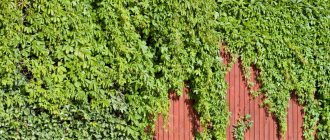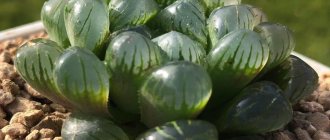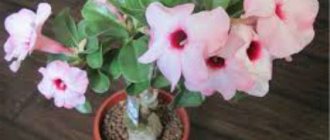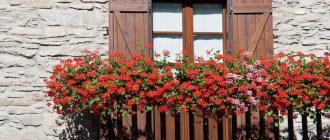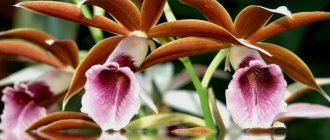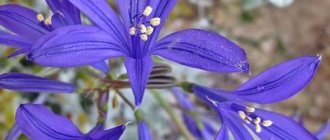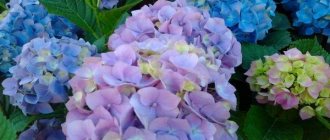Planning the landscape design of a garden and personal plot is an important and exciting moment. After all, you really want to create a blooming paradise in which you can relax after a hard day. Annual flowers for the garden are mainly grown in seedlings and allow the formation of bright and unusual group plantings. Selection of plants will be easier if you use systematized catalogs. This page contains a catalog of annual flowers blooming all summer for the garden with a variety of colors, bud shapes, and stem heights. The names and photos in the catalog will allow you to create your own list and work out the locations of plants in advance. Annual flowers that bloom all summer without stopping require special care; the catalog with photos gives some recommendations, but it is still worth taking the time to study the botanical and agrotechnical characteristics of each specific crop. Many of them are presented on the pages of this site.
Annual flowers blooming all summer: photo and name
Annual garden flowers are often called “annuals”. This designation combines two characteristics at the same time: varieties are intended only for summer flowering and exist in nature for one season, that is, one growing season.
When planning plantings, the gardener is faced with the task of selecting varieties that can delight with budding for a long time. A tricky technique used by experienced owners is a specially extended, phased planting of varietal varieties.
annual flowers blooming all summer photo and name
The cultivation of certain varieties is subject to the rule of sowing seedlings. The seedling approach helps organize planting in the flowerbed, shortens the adaptation period of plants and minimizes the risks associated with the death of seeds from cold and frost.
Diversity makes the choice of gardeners difficult, but at the same time it allows you to try new options and create flower beds that are unique in their beauty. Gardeners are recommended to choose a variety in advance, focusing on photos and names of annual flowers in special catalogs.
Reference! It is customary to plant unpretentious plants with seeds that are frost-resistant and do not require special care.
Multicolor annual flowers with different heights (catalog with photos)
Our catalog with photos continues with annual flowers that bloom all summer with different bud shapes and different stem heights. All of them are multicolored - that is, they can bloom with different colors of buds.
The first is the diverse and beloved “aunt” petunia - this plant can be found almost everywhere. It is grown by seedlings. It is divided into hanging, cascading, creeping and bush forms. Ampelous petunias are an ideal plant for decorating balconies, loggias and terraces. But bush petunia is used to decorate flower beds, flower beds and ridges. The flowers can be double or simple, the color ranges from white to purple.
Purslane can be sown directly into the ground in early May under temporary film cover. The unusual shape of the foliage and stem, combined with the multicolored simple shapes of the buds, creates a fantastic picture. Used in borders, along the edges of flower beds.
Viola belongs to the low-growing creeping forms of garden crops. These annual garden flowers, which bloom all summer, have two-tone petals. The most common combination is white and purple. Look great along garden paths.
The unusual shape of antirrinum buds attracts the attention of not only humans, but also insects involved in the pollination of vegetable and flower crops. Plant these attractive flowers as seedlings and enjoy abundant blooms from early June to late October.
Magnificent caps of pink matiola diversify the plantings. It should be grown in seedlings. Seeds should be sown in early March followed by picking. It has an average height, blooms profusely and for a long time from the end of May until the first frost.
Dimorphotheca has a variety of colors of simple buds. This beautiful chamomile looks great in group thickened plantings along artificial ponds and in flower beds. Weakly susceptible to diseases and pests.
In the catalog of annual flowers that bloom all summer, she is accompanied by cosmos with a stem height of up to 50 cm. The first buds bloom already at the stage of growing seedlings. They can be blue, pink, white, red.
Among the tall forms one can distinguish aruncus, which delights with paniculate inflorescences of a white hue. An excellent honey plant, it attracts many bees and bumblebees to the garden. The stem is densely leafy and perfectly protects shorter flower crops from the influence of gusts of wind.
Datura is a real decoration for any flower garden. This is a tall bush decorated with white bell-shaped flowers. A beautiful dense mass of foliage will camouflage fences and unsightly facades of outbuildings. Among annuals that bloom all summer, it stands out for its rapid growth and rapid development. Blooms long and profusely. Requires the addition of mineral complexes at least once a week.
Decorative beans are designed to diversify the catalog of annual flowers for the garden, blooming all summer, quickly entwining themselves with garden gazebos and hedges.
Annual dahlias are another great variety of flower crops.
Unpretentious annuals
Annual garden flowers that do not require constant monitoring are a godsend for those who are limited in time. The unpretentiousness of plants is expressed in the ability to bloom all summer, even if they are planted in a shaded area. Unpretentious summer plants and their varieties tolerate long periods without regular watering, do not respond to temperature changes and are resistant to common infections.
Information! Unpretentious summer trees are planted when there is a possibility that the garden will be left unattended for some time.
Up to 25 cm
Unpretentious annual flowers are sown by seeds or grown by seedlings. Low bushes, which can create the feeling of a full flower cover, have become widespread among flower growers.
Alyssum
This is a species that belongs to the category of ground cover plants. The bush stretches up to 15-25 cm, the stems branch in all directions, and by the second half of June small multi-colored buds appear on the stems. Alyssum is represented by several popular varieties: “Snow Queen”, “Purple Delight”, “Paletta”.
The unpretentious annual is sown without seedlings in the second half of May or pre-winter November sowing is done. Alyssum grows well in light nutrient soils in direct sun or shaded areas.
For flowerpots
Only certain varieties are grown in hanging structures. They descend from the pendants in waves. Compositions created in this way are used to decorate terraces and gazebos. Hanging pots look great in photos; they are in demand during amateur and professional photo shoots as a decorative element.
Begonia
A photograph of a hanging begonia can mislead a novice gardener. From the outside, begonia simultaneously resembles a peony and a rose. Begonia is a good choice for hanging plantings. It can bloom all summer long and does not require special care. Begonia shoots reach 35-50 cm, cascading flowering ensures complete coverage of the planting container.
Planting and growing
There are two ways to grow annual flowers. The first is from seeds. Seedlings are obtained in advance and young shoots are planted in the ground in the spring. The method is reliable, the flowers have time to get stronger by spring. In this way you can grow begonia, marigolds, pelargonium, petunias, snapdragons, and dahlias.
Recommendations for growing seedlings:
- In March, seeds are sown in a greenhouse or special boxes in an apartment.
- You need to make a drainage layer at the bottom of the container.
- Prepare nutritious soil.
- Before planting, the seeds can be soaked in a nutrient growth stimulant or water.
- Small seeds are scattered over the surface without covering them with soil. Large ones can be slightly buried. If you dig the seeds too deeply, they will take a long time to germinate.
- To create a greenhouse effect, it is better to cover the boxes with film.
- The soil is constantly moistened with a sprayer.
- Grown plants dive.
- Before planting in the ground, the seedlings are taken outside during the day to harden them.
- When warm weather sets in, you can move the young plants to the flowerbed.
The second method is to sown collected or purchased seeds directly into open ground in the spring. Using this method, you can plant calendula, amaranth, decorative peas, and nasturtium.
The seeds are pre-soaked and sown in prepared nutrient soil in a flower bed or flower garden. It is important to constantly water the soil . If shoots are too frequent, you can plant young plants or simply thin them out, leaving the strongest shoots.
Many annuals can be grown from both seedlings and seeds. Some plants have a short flowering period, so that the flowerbed looks beautiful all season long, you can add new seeds every month, remove faded plants and plant new ones.
Annuals for flower beds
Flowerbed or mixborder plantings are a special pleasure for those who annually create unique compositions. Experienced gardeners begin selecting varieties long before the start of the season. The seed catalog helps you select annual flowers for flower beds, taking into account various parameters.
Marigold
The popular and beloved marigolds lead the list of long-flowering annuals. Marigold seedlings in Siberia are planted by the beginning of June. Once budding starts, it does not stop until the first frost. Marigolds produce a bright flower of orange, dark red, yellow or milky hue. The stem reaches a height of 20-30 cm.
Reference! The peculiarity of marigolds is that they are quick and easy to independently collect seeds after flowering.
Calendula
The unofficial name of calendula, which is not recorded by any professional catalog, is “marigold”. It is associated with the shape of the orange-yellow petals. The stems of calendula stretch up to half a meter, the ovaries appear when the air warms up sufficiently, and are renewed throughout the summer. Calendula is a frost-resistant species, therefore suitable for growing in Siberia.
Low-growing annuals
Low-growing annual flowers are a group of plants intended for flowerbed plantings up to 30 cm. They are often planted along the edges of flowerbeds and used to frame or separate areas.
Lobelia
Lobelia can be grown as a perennial species, but seedlings are planted annually. Lobelia is a bush group with buds in blue, lavender or purple shades. It is customary to plant lobelia on alpine hills, create compositions in carpet flower beds, and use them on ridges. Lobelia can delight you with flowering throughout the summer. Lobelia is frost-resistant, loves sunny or shaded places, does not require nutritious soil, and can grow on loamy soils.
Meeting the pilots. Catalog of annual flowers
Any gardener who grows flowers wants his “wards,” to respond to care, to bloom profusely and for a long time to delight and amaze others with their beauty.
There is a large group of flowering plants that can fully meet the stated requirements; these are annual flowers .
The group of annuals includes:
- plants whose life cycle ends in the year of sowing, that is, during one season they germinate, bloom and produce seeds (asters, calendula);
- perennials - plants whose roots die off with the arrival of cold weather, but at the same time the flowers manage to bloom and produce seeds in the year of sowing; it is obvious that in warm, frost-free regions their life cycle does not end after the formation of seeds (nasturtium, snapdragon);
- biennials with forms that bloom in the year of sowing (Carpathian bellflower, Vitrocca violet).
Growing annual flowers guarantees a blooming appearance for the garden until the onset of frost. This is the main feature of summer flowers; only the onset of cold weather can interrupt their flowering.
Most annual flowers begin blooming in early July. Plants grown through seedlings bloom earlier - in June. There is also a large group of plants that are grown using special agricultural technology; such flowers are planted in the ground in May–June already in bloom.
Below is a catalog of annual flowers (alphabetically A-K).
Abbreviations: P – seedling cultivation; G – sowing seeds in the ground; H – propagation by cuttings; sv – light-loving; ten – shade-tolerant; x – cold-resistant; t – heat-loving; c – moisture-loving; h – drought-resistant; k – container; a – aromatic; amp – ampelous; c – dried flowers.
| Photo | Flowering time | Plant height, cm | Coloring | Peculiarities |
| VII-IX | 50-70 | white, blue | R; St.+ten; T; h; To; A | |
| VII-IX | 50-100 | lilac-pink | G; St; X; h | |
| VII-IX | 25-50 | bright red | G; sv+ten; X; V | |
| VII-IX | 30-120 | green, bronze, carmine | G; St; T; h; With | |
| VII-IX | 50-120 | green, bronze, carmine | G; St; T; h; With | |
| VII-IX | 60-80 | white, pink, lilac, yellow | G+R; St; T; h; A | |
| VII-IX | 50-60 | white | G+R; sv+ten; X; h | |
| VI-IX | 20-30 | blue | G+R; sv+ten; X; h | |
| VI-IX | 40-60 | white | G+R; St; X; z;s | |
| VII-IX | 12-20 | bright blue | R; sv+ten; X; V | |
| VII-IX | 12-18 | cornflower blue, red | R; sv+ten; X; V | |
| VI-IX | 30-40 | yellow | R; St; x;z | |
| VI-IX | 60-80 | white | R; St; X; h | |
| VI-IX | 50-60 | white, yellow | R; St; X; h | |
| VI-IX | 25-40 | white, red, pink, yellow, blue | R; St; X; V; To | |
| VII-IX | 40-70 | blue, white | G+R; St; X; h | |
| VII-IX | 40-45 | white | G+R; St; X; h | |
| VII-IX | 50-70 | white, pink, yellow, cream | G; St; X; h | |
| VI-IX | 50-70 | white | G; St; X; h | |
| VI-IX | 30-40 | blue | G; sv+ten; X; h; A | |
| VII-IX | 25-50 | white, pink, red, blue | G+R; St; X; V | |
| VII-IX | 150-200 | red | G; St; T; V; With | |
| VI-IX | 20-45 | yellow, orange, bicolor | G+R; sv+ten; T; h; k;a | |
| VII-IX | 35-100 | cream, yellow, orange | R; St; T; h; To; A | |
| VII-IX | 15-40 | yellow, orange, red | G+R; St; T; h; To; A | |
| VII-IX | 20-70 | White, pink, red, lilac | R; sv+ten; T; V; | |
| VI-IX | 25-45 | white, red, lilac, orange | H; sv+ten; T; V; To | |
| VI-IX | 15-35 | red, pink, white, carmine | R+H; sv+ten; T; V; To | |
| VII-IX | 50-80 | yellow | G; St; X; h | |
| VI-IX | 20-40 | white, pink, blue, blue, lilac | G+R; St; X; h; To | |
| VII-IX | 20-60 | green | G; St; X; V; With | |
| VII-IX | 15-50 | green | G; St; X; V; With | |
| VII-IX | 20-80 | green | G; St; X; V; With | |
| VI-IX | 40-70 | white, pink | G; St; X; V | |
| VI-IX | 35-50 | white, pink, blue, blue | G; St; X; V | |
| VII-IX | 50-70 | orange, white | R; sv+ten; X; h | |
| VII-IX | 100-120 | Amethyst blue | R; St; X; h; With | |
| VII-IX | 20-50 | white, red, blue, purple | R; St; X; h; To | |
| VII-IX | 30-50 | white, pink, lilac | R; St; X; h; To | |
| VII-IX | 30-45 | lilac-pink | R; St; X; h; To; amp | |
| VII-IX | 20-25 | light raspberry | R; St; X; h; To; amp | |
| VII-IX | 15-30 | lilac | R; St; X; h | |
| VII-VIII | 45-60 | blue, pink, purple | R; St; X; V | |
| VI-IX | 60-70 | lilac | G; St; X; h | |
| VII-IX | 15-20 | pink, blue, blue | G; sv+ten; X; V | |
| VII-IX | 30-60 | yellow, pink, purple | G; St; X; h | |
| VI-VIII | 10-25 | yellow | R; St; X; h | |
| VI-IX | 50-70 | white | R; St; X; h | |
| VII-IX | 20-40 | yellow, orange, red | R; St; X; h | |
| VI-VIII | 40-60 | pink, red, motley | G+R; St; X; V | |
| VI-VIII | 20-40 | white, pink. red | G+R; St; X; V; To | |
| VII-VIII | 40-60 | dark purple | R+H; sv+ten; T; h; To; A | |
| VII-IX | 30-40 | bright blue | R; St; X; V | |
| VII-IX | 25-40 | white, pink, yellow, purple | R; St; X; h; With | |
| VII-VIII | 30-70 | white, pink, yellow, red | R; sv+ten; T; V; To | |
| VII-IX | 30-40 | lilac-blue | G; sv+ten; X; V | |
| VII-IX | 40-50 | lilac-blue | G; sv+ten; X; V | |
| VI-VII | 40-50 | White, pink | G; With; X; V | |
| VII-IX | 20-50 | white, pink, raspberry, red, lilac | G+R; St; X; V | |
| VII-VIII | 20-30 | purple, cream, pink | R; St; T; h; With; To | |
| VI-IX | 10-15 | variegated leaves | R+H; sv+ten; T; h | |
| VI-IX | 40-120 | white, pink, blue. blue | G; St; X; V; With | |
| VII-IX | 30-50 | blue, white | G; St; X; V | |
| VI-IX | 60-120 | white, pink. blue, light blue | G; St; X; V; With | |
| VI-VII | 20-30 | pink | G+R; sv+ten; X; V | |
| VII-IX | 40-70 | blue | R; St; X; V; A | |
| VII-IX | 30-40 | orange, cream, salmon | G; St; X; h | |
| VI-IX | 30-40 | white | G; St; X; h; With | |
| VI-IX | 12-15 | white, pink, yellow, crimson | R; St; T; h | |
| VII-IX | 30-200 | white, purple, pink, red, blue, light blue | G+Z; St; X; V; A; amp | |
| VII-VIII | 60-70 | white, pink, light purple | G; St; X; h; A | |
| VII-VIII | 30-40 | white | G; St; X; V | |
| VII-VIII | 25-40 | pink, lilac, lilac | G; St; X; V | |
| VII-IX | 40-60 | red | R; St; X; V; To | |
| VI-VIII | 25-80 | cream, yellow, orange | G+R; St; X; V; To | |
| VII-IX | 25-50 | yellow | R; sv+ten; X; h; To | |
| VIII-X | 25-100 | white, pink, red, green | G+R; sv+ten; X; V | |
| VI-IX | 40-50 | blue, yellow, pink | R; St; X; h; With | |
| VI-IX | 35-50 | yellow | G+R; St; X; h | |
| VII-VIII | 40-90 | white, raspberry, pink, salmon | G; St; X; V | |
| VI-VIII | 40-50 | lilac, white | G; St; X; V | |
| VII-IX | 80-100 | pink, lilac, white | R; St; T; h | |
| VIII-IX | 120-150 | purple leaves | G+R; St; T; h | |
| IV-VIII | 30-50 | light yellow, red, motley | R; sv+ten; T; V; To | |
| VII-VIII | 20-40 | white-pink | G; sv+ten; X; V | |
| VII-IX | 20-25 | white, blue | R; sv+ten; X; V | |
| VI-IX | 40-100 | yellow, orange, red-brown | G; St; X; h | |
| VII-IX | 60-120 | lilac, pink, white, carmine | G+R; St; X; h | |
| VIII-IX | 50-60 | yellow, orange, red | G+R; St; X; h | |
| VII-VIII | 40-60 | green | G; St; X; V; With | |
| VII-VIII | 40-60 | green | G; St; X; V; With | |
| VI-IX | 50-100 | green | G+R; St; T; V | |
| VII-IX | 30-40 | white, pink | G+R; St; X; V | |
| VII-IX | 30-40 | dark purple | R; sv+ten; T; h | |
| VII-IX | 25-30 | red | R; sv+ten; T; h | |
| VII-IX | 30-60 | white, pink, purple, lilac | G+R; St; X; h; With | |
| VI-IX | 60-150 | white, pink, purple | G+R; sv+ten; X; h | |
| VII-VIII | 30-60 | creamy | G; sv+ten; X; V; With | |
| VII-VIII | 20-40 | green-golden | G; St; X; V; With | |
| VI-IX | 25-40 | white, pink. lilac, blue | G+R; sv+ten; X; V; To; A | |
| VII-IX | 30-50 | yellow with white | G; St; X; h; A | |
| VI-IX | 40-80 | red | G; St; X; behind | |
| VI-IX | 15-20 | white with yellow | G; sv+ten; X; V; amp | |
| VI-IX | 20-30 | light pink | G; St; X; V | |
| VI-IX | 25-35 | yellow with white | R; St; X; h | |
| V-IX | 25-35 | blue, white, lilac | R; sv+ten; X; V; To | |
| V-IX | 20-40 | white, pink. blue, blue | R; sv+ten; X; V; To; amp | |
| VI-IX | 10-40 | white, pink | G+R; sv+ten; X; V; To; A | |
| VII-IX | 30-50 | yellow | R; St; X; V; With | |
| VI-VIII | 30-50 | pink, red, yellow, lilac | R; St; X; V | |
| VII-IX | 20-80 | white, pink. yellow. red | R; St; X; V; To | |
| VI-IX | 40-50 | red | R; St; X; V ; | |
| VII-VIII | 50-100 | pink, red | R; St; X; V; With | |
| VII-IX | 60-100 | white, pink | G; St; X; h | |
| VII-IX | 15-35 | pink, lilac | G; St; X; V; To | |
| VI-VII | 35-60 | pink, lilac | G; sv+ten; X; h; A | |
| VI-IX | 30-50 | yellow | R; St; X; h; A | |
| V-IX | 20-30 | motley | R; sv+ten; X; V; To | |
| V-IX | 20-30 | yellow-red | R; sv+ten; X; V; To | |
| V-IX | 15-20 | yellow | R; sv+ten; X; V; To | |
| VII-VIII | 60-70 | white, pink, red, yellow | R; St; T; h | |
| VII-IX | 90-100 | lilac | R; sv+ten; X; h; With; A | |
| VI-VIII | 35-200 | orange, yellow. red | G+R; St; T; h; To; A; amp | |
| VI-VIII | 150-300 | yellow | G+R; St; T; h; To; A; amp | |
| VI-IX | 30-40 | red, yellow, pink, purple | G+R; sv+ten; X; V; To | |
| VI-IX | 20-30 | white | G+R; sv+ten; X; V | |
| VI-IX | 20-25 | blue | G; St; X; V | |
| VI-IX | 20-25 | white | G; St; X; V | |
| VII-VIII | 30-40 | white | R; St; X; V; To | |
| VII-VIII | 30-50 | white, pink, blue | G; St; X; h; With | |
| VII-IX | 50-100 | blue | R; sv+ten; T; h; With | |
| VII-IX | 15-25 | purple, white | R; St; X; h; To | |
| VI-IX | 15-24 | blue | R; St; X; h; To | |
| VI-IX | 25-50 | white, pink, red | R+H; sv + ten; T; V; To | |
| VI-IX | 50-90 | white, pink, red, lilac | R+H; sv+ten; X; V; To; amp | |
| VIII-IX | 40-60 | red, pink, carmine | R; St; X; V | |
| VII-VIII | 80-100 | brown-red | R; St; T; V | |
| VI-IX | 20-75 | white, pink, red, blue | R; St; X; h; To; A; amp | |
| VII-IX | 20-75 | white, yellow | R; St; X; h; To; A | |
| VII-IX | 60-200 | cream, yellow, purple | G; St; T; h | |
| VI-VIII | 30-80 | pink, lilac-pink | G+R; St; X; V; With | |
| VI-VIII | 30-50 | green | G+R; St; X; V; With | |
| VII-IX | 8-15 | white, pink. yellow, red | R; St; T; h; To | |
| VII-IX | 50-60 | green-white | G+R; sv+ten; X; V; A | |
| VI-VIII | 30-60 | yellow-green | G+R; sv+ten; X; V; A | |
| VI-IX | 30-100 | yellow | R; St; T; h; With; To | |
| VI-IX | 30-70 | yellow with brown | R; St; T; h; With | |
| VII-IX | 40-60 | blue, blue | R; St; T; h; With | |
| VII-IX | 50-70 | blue | R; St; X; h | |
| VI-IX | 20-50 | red, pink. purple | R; St; T; h; To | |
| VI-IX | 50-70 | white, pink. purple | R; St; X; h | |
| VI-IX | 50-80 | red | R; St; T; h | |
| VI-IX | 40-70 | red, blue, yellow. pink, purple | G+R; St; X; h; To | |
| VI-IX | 15-25 | yellow | R; St; T; h; To | |
| VII-VIII | 40-100 | green, brown | G+R; St; X; h; With | |
| VII-IX | 30-40 | raspberry | G; sv+ten; X; V | |
| VII-IX | 20-25 | white, pink | G; sv+ten; X; amp | |
| VII-IX | 30-80 | white, pink, dark purple, lilac | G+R; St; X; h; With | |
| VI-VIII | 20-40 | white, pink. motley | G+R; sv+ten; X; V |
The catalog of annual flowers (in alphabetical order T-Z) can be found here.
<< Once upon a time there lived one little man, Dried Flowers. Catalog of annual flowers (continued)>>
Shade-loving annuals in alphabetical order
Garden annual flowers that prefer shade are distinguished by the rich color of their foliage. Usually dark green leaves are surrounded by buds of deep cool shades. The warm climate allows you to choose varieties that are contraindicated for regions with low night temperatures.
A heat-loving, blooming annual flower, as a rule, is distinguished by the special brightness of its petals and the variety of shapes of its inflorescences. Flower varieties require special care if the dacha or estate is constantly in partial shade.
It is much easier to choose annual flowers, photos and names of which are collected alphabetically. Listed below are the most popular garden plots.
Antirrinum
The common name for the beautiful antirrinum is snapdragon. The description doesn't convey its charm. The plant resembles a pyramid, with the main stem rising slightly above the bright inflorescence. Snapdragon blooms from June to September, subject to the necessary care rules. Antirrinum has no requirements for choosing a location: it grows in sunny places and in shaded areas.
Balsam
One of the most beloved shade-loving species by gardeners. Impatiens are used to decorate any flower beds. It is a plant with a stem reaching 20-50 cm, with simple 4-petalled buds. As the balsam grows, it takes on the shape of a ball, so it is customary to plant it on alpine hills or flower beds made on a hill.
Godetia
A simple border plant with pastel colored petals. The stem stretches up to 30-40 cm, the upper part is crowned with small inflorescences. Godetia loves partial shade and begins to react by yellowing of the leaves when the soil is overwatered.
Cosmea
An unpretentious species that blooms all season. The peculiarity of cosmos is the growth of a long stem with a single pink bud. Cosmos plantings must be carefully planned. It will enliven compositions of densely growing varieties, but will not become the center of the flowerbed, and is also not suitable for planting in ridges. Cosmea exhibits frost resistance. Flowering intensity decreases if it does not receive maximum sunlight.
Salvia
Salvia loves sunny, open areas and does not tolerate waterlogged soil. Salvia is a plant with an elongated stem, on which bright red buds with a diameter of up to 3 cm are formed alternately on both sides. Hybrid varieties of salvia come in a variety of shades: from lilac to pink.
Zinnia
An ideal summer option that fits into different compositions. Zinnia is used for any type of flower beds, thins out, delimits plantings, and colors mixborders with bright colors.
Zinnia grows up to 50-70 cm, the bud is a bright cap, which is securely attached to a dense, erect stem. The diameter of the bud reaches 15 cm. Zinnia is sensitive to low temperatures, so it is planted in sunny places where draft winds and prolonged stay in the shade are excluded.
Fruiting annuals
No less popular than flowers are crops whose fruits can be used for food. The names of annual plants of the fruit-bearing group are no less numerous than those of flowering ones.
Root plants
Potato . Everyone is familiar with the root vegetable, which is used as a side dish. It is planted at the end of April - beginning of May and dug up after the tops dry. In fertile years, you can get up to 10-12 tubers from one plant.
Carrot . Another root crop, it is sown in open ground to a depth of no more than 1 cm. Usually the plant sprouts very quickly and often requires thinning. Carrots are collected at the beginning of autumn, without waiting for the top leaves to die off.
Family Solanaceae
Tomato . Another bright representative of vegetable gardens. Seedlings are planted at the end of February and planted about a month later. They are transferred to open ground towards the end of May. Homemade tomatoes are distinguished by their meatiness and rich, sweet taste, which can be tasted as early as late July - early August.
Pepper . Often sown simultaneously with the previous brother. It also peaks about a month after germination. The fruits are harvested in August.
Pumpkin vegetables
Cucumber . This vegetable is very popular. Its seeds are sown at the end of May under film, and after 1.5 months the first fruits can be harvested. The plant loves oily, moist soil. It is often used in diets because the calorie content of the fruit is practically zero, since it consists of more than 95% water.
Zucchini . It has a large amount of useful substances; both its pulp and the seeds inside the fruit are edible. Its stems are slightly prickly and spread along the ground. The vegetable is usually planted close to the potato, usually along the edge of the plantation, so that it does not interfere with the growth of other plants.
Leaf crops
Cabbage . Planted in the form of seedlings. The distance is at least half a meter from each other. At first the plant looks unsightly, but as it grows it gains strength, and its leaves spread over a distance of up to 50 cm. Over time, they form a dense bud, which is commonly called a head of cabbage.
Dill . A well-known plant with a rich aroma, it is difficult to confuse it with something else. Unpretentious, once it appears among the beds, it will grow every year. It is used as a seasoning for preparing first and second courses, as well as for pickling other garden crops.
When choosing what to plant on your site, it is important to decide what goal is being pursued. Plants from the first group will delight the eye with their beauty and grace, while the second group will also delight the stomach.
Often in Russian gardens combined options are used: part of the soil is given over to edible crops, and the other for decoration. In this case, annual plants have a number of advantages over perennials, because they can always be swapped or not used at all in the current season.
Climbing annuals
Climbing annual flowers, the photos and names of which delight even experienced gardeners, are suitable for growing in the middle zone. They tolerate low air temperatures well, grow quickly and help decorate the chosen space.
Beautiful annual flowers of the liana type are a separate category. Lianas need supports on which they will quickly climb after planting. An important condition for growing is the isolation of planting vines. The root system of vines grows on the sides, it requires a lot of space, which excludes close plantings of other species.
Convolvulus
This is a low-growing creeping plant that, with careful care, can grow without special support. Owners need to promptly remove spent inflorescences and trim the stems to correct the growth. The shape of the bud resembles a gramophone, the shades of the petals belong to the cold range category.
Rodochiton
The liana reaches 3 m during the summer. Leaves with jagged edges are planted on flexible stems; a 5-petalled tubular bud of wine color is formed on each perianth. Rhodochiton is planted near buildings so that the vines can climb up the support. Rhodochiton can decorate any garden plot if planted in sunny areas.
Flowering annuals for the garden
The golden time for summer flowers to bloom is in July. Midsummer is characterized by consistently warm weather. By this month, flower growers have fully formed flowerbed arrangements; they can only observe the fruits of their labor and make sure that faded buds do not interfere with further flowering.
A flowerbed in a country house is often left unattended if the owners do not live in the house seasonally. This means that it is necessary to select varieties of summer flowers for the site so that they do not require constant attention, but at the same time support the flower arrangement.
Verbena
A beautiful low-growing species that can bloom from June to September if enough space is allocated for planting. Verbena needs regular sunlight, but is frost-resistant and drought-tolerant. The only thing that verbena does not like is soil overflow.
Verbena comes in blue, purple, dark red and white. The shade determines the varietal affiliation. Stems with pronounced internodes are crowned with inflorescences with small buds of 5 petals. Verbena creates the feeling of completely covering the soil.
Unpretentious annuals for flower beds
Among the most unpretentious plants, there are several varieties, without which it is difficult to imagine a summer flower bed. A detailed description helps you choose the appropriate option for your garden or plot.
Phloxes
All gardeners love annual phloxes. Phlox seedlings take root well without loss and do not require special care during flowering. Phlox grow up to 15 cm, they have small leaves and petals. At the same time, the inflorescences amaze with their abundance. Small buds of different colors on nearby bushes create a colorful picture. Phlox is used to decorate flower beds, borders, and mixborders. The density of flowering allows them to be used to delimit zones.
Pink
Dianthus
Recently, the practice of planting flowers of the same shade has become widespread among flower growers. The plot looks especially elegant, but the possibility of a varietal error cannot be ruled out. A bushy plant with small cloves at the top of the stem. The buds come in pink and dark pink shades. Carnation grass provides good shade to neighboring plants. Carnations are planted around the perimeter of the flower bed or used to border borders.
White
Iberis
Snow-white buds fit perfectly into multi-colored flower beds. They dilute the color scheme and help place accents. Bush Iberis covers the space with white caps of buds. The stems stretch up to 30 cm, do not fall off, do not break in the rain, and create a good planting density. Iberis loves light soils and does not tolerate overwatering. To achieve active long flowering, it is necessary to sow Iberis in an open sunny area.
Orange
Calceolaria
The most popular orange garden varieties are marigolds. Varieties are available in different shades of orange. The second most popular orange flower is calendula. In addition to the leaders, there are orange varieties that are less common.
The beautiful orange calceolaria is known for its unusual petal structure. Calceolaria belongs to the category of low-growing varieties. She loves the shade, as she has velvety light green leaves, which are damaged by direct sunlight. Flowering lasts all summer, provided the right place for planting is chosen.
Tall annuals suitable for the garden
Tall annuals can become the central plant in a tiered flowerbed or act as a tapeworm.
Flowers in warm colors
- Belamkanda - Chinese orchid or leopard lily - is an amazingly ornamental plant. Every morning flowers bloom like lilies, which die in the evening, giving room in the sun to the next buds. Group planting of several specimens looks impressive alone or as an accent in the center of a flower bed. An exceptionally sunny plant. Photo:
- Gaillardia . Burgundy, red, orange flowers with a yellow border on erect stems form a luxurious bush that can become a bright accent in a flowerbed or stand out in an open area. Photo:
You may be interested in: Pelargoniums in flower beds and flower beds: how to plant, the basics of proper care
- Impatiens - a dense green bush dotted with pink, red or white flowers looks impressive in flowerpots and group plantings
- Annual hollyhocks, planted in a dense wall, can decorate a hedge and designate functional zones on the site. Photo:
- Cosmea is a whole palette of colors and juicy openwork greens. Feels great in the sun and shade.
Tall plants with flowers in cool colors
- Asters are flowers of the second half of summer; they do not lose their decorative effect until frost. All shades of blue, violet, lilac - cold stars in the flowerbed
- Heliotrope is a thick cap of bright blue or deep purple inflorescences.
Long-blooming annual flowers
Every gardener dreams of long, abundant flowering in a created flower bed. The advantage of annuals is that the owner can mix selected varieties every year, experiment, and create unique compositions.
Lavender
Narrow-leaved lavender belongs to the group of plants with cool colors. Petals of a purple or blue hue form small flowers, which are alternately located on an erect stem. Only certain varieties of lavender can bloom all summer, so you should pay special attention to this when choosing.
Lavender is a good neighbor for whimsical roses. It is suitable for planting next to ornamental grasses and can grow in a natural monochrome composition.
Reference! "Hidcote" and "Munstead" are lavender varieties that can bloom from June to September.
Nasturtium
The bud formation of nasturtium minor lasts from June to October. The stems stretch up to 30 cm, the petals have a variety of deep shades of orange, red, and burgundy. Nasturtium is suitable for any type of flower bed. The plant performs well as a limiter for garden areas, and is also used in decoration as a filler for hanging structures.
Types of annual plants
Annuals are flowers with one growing season and are especially popular among gardeners. The choice of varieties is huge, but most often the earliest and most cold-resistant species are planted in flower beds, which can be grown even in regions with unstable weather conditions.
The most popular types of annual crops:
- Marigold. A fast-growing, unpretentious flower. Loves warmth and tolerates drought easily. Blooms well and abundantly in some shade. Double flowers of yellow, orange, red-brown hue look very attractive. It is grown both by seedlings and by sowing in the ground. Any variety blooms for a long time in the garden, on terraces and balconies.
- Cosmea. An unpretentious plant takes its rightful place in modern landscape design. The tall stems of cosmos are shrouded in delicate foliage that resembles thin needles. The flowers are soft pink, lilac, burgundy, purple. Cosmos blooms all summer; when mature, it is a branched bush that goes well with other types of plants in the flowerbed.
- Snapdragon. This annual flower is experiencing a rebirth. Modern varieties resemble large gladioli; flower stalks can reach 50 cm. Flowers of various shades, from white to dark purple, are collected in large spike-shaped inflorescences. Light-loving and cold-resistant plant, tolerates frosts down to -3 °C. Most often grown by seedlings. Snapdragon not only decorates flower beds, but is also used as a cut flower. In bouquets and compositions it retains its decorative effect for a long time.
- Nasturtium. A perennial plant of the southern climate, we grow it as an annual plant. A heat-loving crop that does not tolerate frost or drought. It comes in bush and creeping forms. Beautiful flowers of various shades with a waxy coating and a pleasant aroma. It is grown by sowing seeds in the ground. Blooms profusely until frost.
- Petunia. A very beautiful and unpretentious plant, popular with gardeners. Blooms profusely from July to October. The flowers are funnel-shaped, plain and variegated. Petunia loves moist soil; heavy soil with the addition of humus, which dries out more slowly, is also suitable for it. It blooms long and profusely until the coldest weather. Can be planted in a flowerbed or in outdoor pots. For the winter, you can transplant it into a flowerpot and bring it indoors.
- Zinnia. A tall annual plant on an erect stem. The flowers are large, single-petaled, shades from violet to purple. It grows quickly, but with a lack of light it stretches out. The stems become thinner and may fall to the ground. It winters well only in the southern regions, and in the central zone of the country it can freeze out.
To create a thick plant carpet on the site, varieties with openwork, dense foliage and large, bright flowers are suitable. Light-loving annual flowers appear in all their glory only in a moist, well-lit area.
Annuals without seedlings
Flowering annuals, photos and names of which are familiar to everyone from childhood, are grown not only with the help of seedlings. The seedless growing method is widespread in the southern regions. Air and soil temperatures allow plants to quickly take root and gain color.
Attention! In regions where climatic conditions are unstable, when frosts are possible or it rains frequently, it is necessary to carefully plan plantings.
cornflower
Cornflower is planted in the second ten days of May. It is not afraid of cold weather and recurrent frosts, and loves nutritious soils. Growing cornflower involves taking into account one feature - for active growth and flowering, it is important that sunlight regularly reaches the leaves.
Cornflower stems are distinguished by their apparent fragility. The bud has a recognizable characteristic shape. If you follow the growing rules, the color of the petals will be rich, bright blue.
Advantages and disadvantages
A rare perennial blooms in the first year of planting, and annual plants will very quickly decorate the garden. Summer flowers bloom throughout the season and are indispensable in creating carpet flower beds, where the accuracy of the lines is important. Perennial flowers, growing, will disrupt the outlines of such flower beds, and annuals will retain a clear compositional planning.
With the help of annuals, you can easily update the landscape design of your garden, because they only grow for one year. For those gardeners who like to transform their plot every year and plant new flower beds, planting annual plants will be a good help.
Among the disadvantages, first of all, we can highlight the fact that certain types of annuals are grown as seedlings, and this means additional concerns about maintaining the necessary conditions (lighting and humidity).
Rare annuals
The plants, which are well known in the floriculture community, are fairly easy to care for. Not everyone decides to land rare flyers, which have an unusual appearance and require special attention.
Molucella smooth
Molucella cannot be overlooked; it fits seamlessly into traditional flower beds, but at the same time retains its own individuality. On the erect stem of the molucella there are white small buds, but they are almost invisible due to the fact that each of them is surrounded by light green cups protruding above the stem. Molucella stretches up to 1 m. The plant needs sunlight and regular watering.

